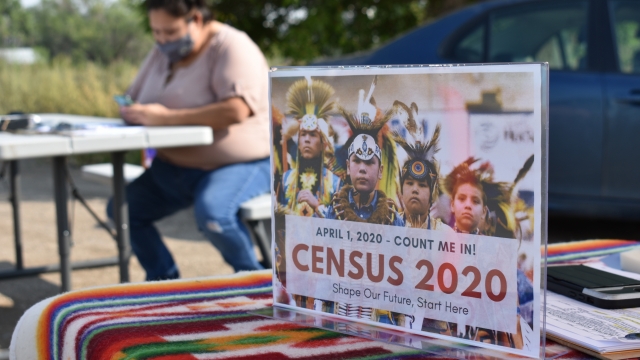Black, Hispanic and American Indian residents were missed at higher rates than a decade ago during the 2020 census, according to a report released Thursday that evaluated how well the once-a-decade headcount tallied every U.S. resident.
Even though the 2020 census missed an unexpectedly small percentage of the total U.S. population given the unprecedented challenges it faced, the increase in undercounts among some minority groups prompted an outcry from civil rights leaders who blamed political interference by the Trump administration, which tried unsuccessfully to add a citizenship question to the census form and cut field operations short.
"These numbers are devastating. Once again, we see an overcount of white Americans and an undercount of Black and Hispanic Americans," National Urban League CEO Marc Morial said on a call with reporters.
"I want to express in the strongest possible terms our outrage."
The results of the U.S. Census Bureau's Post-Enumeration Survey showed that most racial and ethnic minorities were overlooked at statistically significant higher rates than a decade ago, with the Asian population being an exception.
The survey measures whether certain populations were undercounted or overrepresented in the census.
Overcounts take place, for example, if someone owns a vacation home and is counted there as well as at a permanent home address.
The Black population in the 2020 census had a net undercount of 3.3%, while it was almost 5% for Hispanics and 5.6% for American Indians and Native Alaskans living on reservations.
Those identifying as another race had a net undercount of 4.3%.
The non-Hispanic White population had a net overcount of 1.6%, and Asians had a net overcount of 2.6%, according to the results.
In the 2010 census, by comparison, the Black population had a net undercount of more than 2%, while it was 1.5% for the Hispanic population.
There was almost a 4.9% undercount for American Indian and Alaskan Natives living on reservations, and it was 1.6% for people identifying as some other race and 0.08% for Asians.
The non-Hispanic White population had a net overcount of 0.8%.
The 2020 census missed 0.24% of the entire U.S. population, a rate that wasn't statistically significant, while it missed 0.01% in the 2010 census.
The census figures help determine the distribution of $1.5 trillion in federal spending each year as well as how many congressional seats each state gets.
Any undercounts in various populations can shortchange the amount of funding and political representation they get over the next decade.
In the years leading up to the 2020 census, advocates worried that a failed attempt by the Trump administration to add a citizenship question to the census questionnaire would scare off Hispanics and immigrants from participating, whether they were in the country legally or not.
The Trump administration also unsuccessfully tried to get the Census Bureau to exclude people in the country illegally from numbers used for divvying up congressional seats among the states and cut short the schedule for field operations that had been extended because of the pandemic.
During a conference call Thursday, Census Bureau Director Robert Santos said many Latino communities throughout the U.S. suffered during the pandemic from joblessness and housing insecurity, and that played a role in the undercount.
But he added that the Trump administration's actions also may have had an impact.
"I'm personally not surprised to see the results we see today," said Santos, who was sworn into the position at the beginning of the year.
The severe undercount of the Hispanic population helps explain why three states with large Latino populations underperformed in the 2020 census, with Arizona failing to gain an extra seat, Florida gaining only a single seat and Texas getting only two seats, said Arturo Vargas, CEO of NALEO Educational Fund.
"It was startling to me, the level of undercount," Vargas said. "We knew there was going to be an undercount, but the extent of it took me by surprise."
About 70% of Native Americans live on reservations. James Tucker, the chairman of a Census Bureau advisory committee, estimated the undercount translates to at least 100,000 Native Americans on reservations not counted and more than a $300 million loss in federal funding for Indian Country annually.
"This undercount is not new, it is a continuous cycle of erasure of Native people from society," said Lycia Maddocks, a citizen of the Fort Yuma Quechan Indian Tribe in Arizona who is political director of NDN Collective, a South Dakota-based advocacy group.
"In a practical sense, an undercount means that Native people are not looked at as a significant voting block when in reality, our population has proven itself to be the margin of victory in key states such as Arizona."
The pandemic disrupted census operations and schedules, and it made residents wary of opening their doors to answer questions from census takers.
Wildfires in the West and hurricanes in the Gulf Coast sent residents fleeing from their homes during the door-knocking phase of the headcount.
The Post-Enumeration showed that 18.8 million people weren't counted correctly in the 2020 census.
Although some of them may have been missed, others were counted using a statistical technique that fills in missing data.
After the results of the Post-Enumeration Survey were released, dozens of members of the Congressional Black Caucus sent a letter to the Census Bureau asking how it planned to investigate the undercount.
"A Census that does not accurately represent Black communities robs them of their equal share of federal resources in education, health care, housing, nutrition assistance, and many other areas ”perpetuating systemic racism," the letter said.
Additional reporting by The Associated Press.
Newsy is the nation’s only free 24/7 national news network. You can find Newsy using your TV’s digital antenna or stream for free. See all the ways you can watch Newsy here: https://bit.ly/Newsy1




